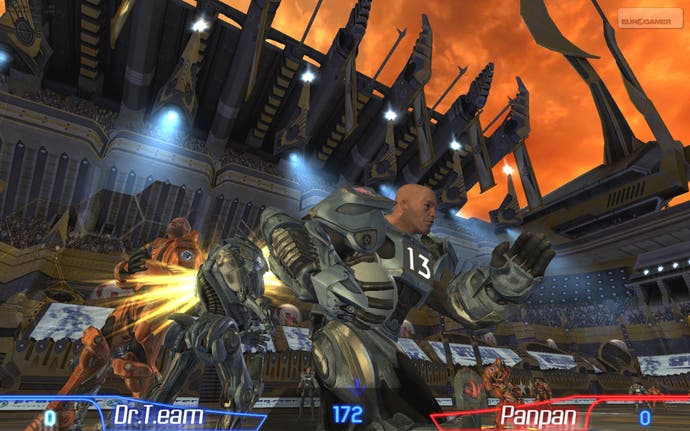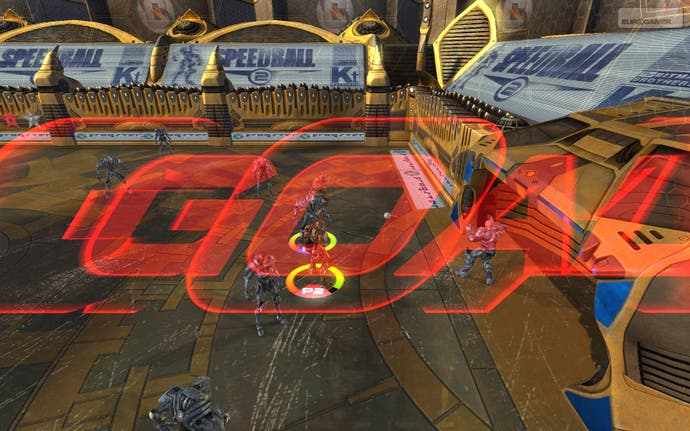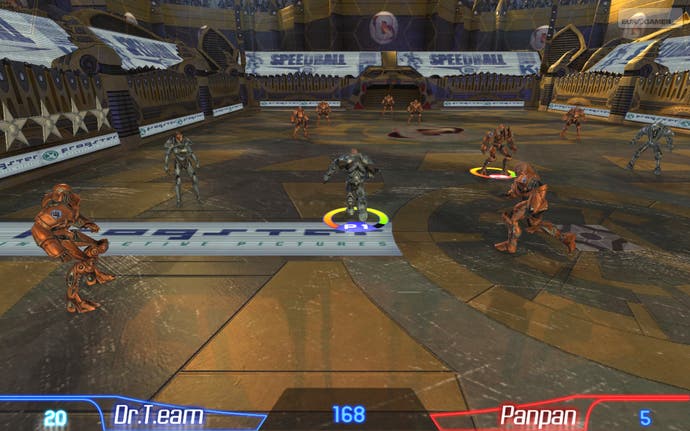Speedball 2 - Tournament
Shoulder pads now back in style.
It's more than a little weird that, after sixteen years of being little more than a fond memory for those who came of age during the last gasp of the quaint "home computer" era, we're faced with two new Speedball games. In fact, the whole Amiga scene - so quickly trampled into the dust once those spanky 16-bit consoles bounced into view - has been undergoing an impressive resurgence of late thanks to the likes of Xbox Live Arcade and Steam. Spookily, as it's gone a bit nippy and I can't be arsed turning the heating on, I've just thrown on the nearest item of clothing and realised that it's an old plaid shirt. All I need to do is cue up some Sonic Youth, grow back my virginity and it could be 1991 all over again.
Unlike the recent port of Brutal Deluxe on XBLA, this part sequel/part update actually tinkers with the guts of Speedball and thus can't coast on nostalgia alone. Even with original creator Mike Montgomery at the helm, the spectre of over-compensation loomed large. Thankfully, despite several surrounding tweaks, the gameplay is virtually identical to how it was way back when. However, that's not to say that this modern makeover has been a complete success.
The most immediately obvious change is graphically. While the burly Bitmap Brothers shoulder pad style has been retained, the chunky sprites of old are now more slender and lithe polygon beasts. Unlike the rather gruesome updated visuals available in the XBLA release, this is a smart and welcome update. You see more of the arena (different viewpoints are also available) and there are more players on screen at a time. The default view is at a nice distance, allowing you to enjoy the new details, but offering greater scope for plotting a course to the goal and finding space for your team-mates.

The controls are another area where things are mostly the same, yet different. You can now use hotkeys to change your formation on the fly, as well as instantly jump to the goalie - both of which are handy and sensible inclusions. Also extremely useful is the ability to target your nearest team-mate, which makes passing a much more fluid affair. There are no new manoeuvres - not that the game really needed them - but the array of movement options from the original Speedball 2 has been given room to breathe all the same. Freed up from the restrictions of one-button joysticks things like high and low throws, sliding, dashing and jumping are all assigned their own keys and are therefore much easier to pull off, making those last minute scrambles to the goal all the more satisfying. It's not going to trouble to the likes of Pro Evolution Soccer for athletic variety, but it's hard not to beam when you run a cheeky dummy around the defense, leap over a sliding tackle and wallop the ball into the goal with a crunch. It's still a hell of a fun game.
If you have a gamepad, that is.
Playing Speedball on the keyboard is, frankly, a horror show. Basic player control is fatally hamstrung by the WASD set-up, which makes simple evasive manoeuvres a real trial, while using the mouse to throw sounds a lot better in theory than it is in practice. And with all the other moves scattered across other keys, it can become an impossible scramble to reach and use them effectively in such a fast-paced non-stop game. Everything can be mapped to whatever keys you fancy, of course, but there's no getting away from the fact that, without sticks and buttons, even the best player is going to flounder.
There are some minor grievances that bear mentioning. The truly wretched loading times, for instance. The sliding tackle isn't as effective as you'd hope either - a rather feeble skid rather than a shin-crunching powerslide. It'd also be handy to have an indicator as to which player actually has the ball, since it's far too easy to lose track in a major ruck. But, as I said, these are trivial annoyances and certainly not enough to detract from an otherwise commendable update.

The majority of the biggest changes to the formula have, wisely, been tacked around the central gameplay rather than all over it like a primary school macaroni collage. There are some perfunctory team management options - you can upgrade your players, or save up to buy new, tougher, special characters. It's a nice idea carried over from the original, but rather half-hearted in its approach here. There are only three character models - big robot, big bloke, big woman with a big ponytail - and they all animate the same, so giving them different names and stats doesn't bring much to the proceedings.
And, of course, being available on Steam, there's online play. This was the area I was most looking forward to, since it seems natural that the biggest benefit of bringing Speedball into the 21st century would be the ability to have actual ongoing global leagues. Well, the option is certainly there - though the rather crude implementation leaves the realisation of this dream up to you. For one thing, clicking the multiplayer menu option just takes you to a login page. Login? Yes, you're supposed to have registered at the Frogster website before you can access the multiplayer servers and rather unforgivably there's no way of doing this from within the game. So you have to write down the website address - with a pen, for God's sake - and quit out of the game so you can set yourself up...
Tell you what - I'll save you some hassle.

Silly, right? Anyway, with that done, you're now free to reload Speedball and play using the dedicated servers. And, once you've done that, it actually works fine, even if it's a little sparsely populated (mostly by Germans, at the moment). The system isn't exactly buzzing, but there is the beginning of a community so we'll have to see how it develops. However, if you really want to keep track of your team, or your clan, it's all done on the Internet since the game only boasts a very crude and functional lobby. The website itself isn't the most professional, with some less than intuitive menu design and muddled English translation, so it hardly makes you want to jump in and start contributing. I don't think anybody was expecting something like Halo 3's multi-faceted Forge, but considering how well other budget Steam titles have managed to integrate community features in-game, this falls far short of expectations.
Still, for as long as you're in the arena itself, lobbing balls and crunching faces, Speedball 2 Tournament is exactly how you'd wish all classic games could be updated. The beloved and well-balanced gameplay has been approached with care and reverence, but changes and tweaks have been made to keep everything in line with modern expectations. It's in the surrounding features - the under-nourished team management, the disconcertingly scrappy online setup - that minor disappointment lingers. It may not be full price but at USD 39.95 (GBP 19 / EUR 27) - only a fiver cheaper than the 1991 version - I don't think it's too cheeky to expect a little more meat on the bone and a lot more polish.








